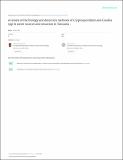| dc.contributor.author | Lyimo, Beatus | |
| dc.contributor.author | Buza, Joram | |
| dc.contributor.author | Shahada, Fransis | |
| dc.date.accessioned | 2019-10-10T12:35:55Z | |
| dc.date.available | 2019-10-10T12:35:55Z | |
| dc.date.issued | 2014-04 | |
| dc.identifier.uri | http://dspace.nm-aist.ac.tz/handle/123456789/484 | |
| dc.description | Research Article published by World Journal of Water Resource and Environmental Science | en_US |
| dc.description.abstract | Cryptosporidium and Giardia species are the two most common enteric protozoan pathogens which affect humans worldwide. In both developed and developing countries. In immunocompetent individuals they cause self limiting diarrhea, which may disappear after 2-3 days, but it is potentially life threatening in immunocompromised persons and children under the age of five years. Contaminated water plays a critical role in the transmission of these pathogens in the form of oocysts and cysts respectively. In the past 20 years, a number of detection methods have been developed to detect both Cryptosporidium spp and Giardia spp in the water samples. These methods have been used for monitoring the occurrences of Cryptosporidium spp and Giardia spp in the raw water intake and understand removal efficiencies at different level of the treatment train. This article aims at reviewing the biology and current detection methods of Cryptosporidium and Giardia spp in the water and current situation in Tanzania. | en_US |
| dc.language.iso | en | en_US |
| dc.publisher | World Journal of Water Resource and Environmental Science | en_US |
| dc.subject | Cryptosporidium | en_US |
| dc.title | A review of the biology and detection methods of Cryptosporidium and Giardia spp in water sources and situation in Tanzania | en_US |
| dc.type | Article | en_US |

